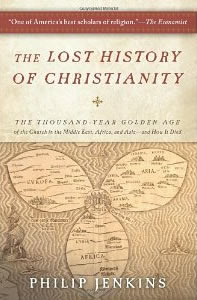Book Notes
 Philip Jenkins, The Lost History of Christianity; The Thousand-Year Golden Age of the Church in the Middle East, Africa, and Asia — and How It Died (New York: HarperOne, 2008), 315pp.
Philip Jenkins, The Lost History of Christianity; The Thousand-Year Golden Age of the Church in the Middle East, Africa, and Asia — and How It Died (New York: HarperOne, 2008), 315pp.
When I was in seminary, I didn't learn much about the Nestorians or the Monophysites, except that both were labeled heretics by Protestant, Catholic, and the eastern Orthodox churches alike. In 431 the Council of Ephesus declared the Nestorians heretical for their view that the two natures of Christ were not united but distinct. The Monophysites believed that Christ had only one nature, not two, and so were condemned at the Council of Chalcedon in 451. Consequently and tragically, as Philip Jenkins shows, the histories of both traditions were "lost" to almost all the rest of Christendom.
This is startling for several reasons. Both the west Syrian Monophysites (or Jacobites), and the east Syrian Nestorians or Assyrian Church of the East in what are now Iraq and Iran, affirmed the decrees of the council of Nicea. The Nestorian patriarch Timothy (c. 800), for example, pointed out the fundamentals of the faith that all Christians shared, including the Trinity, Incarnation, baptism, adoration of the cross, Eucharist, the two testaments, the resurrection of the dead, eternal life, the return of Christ, and the last judgment. "We must never think of these churches as fringe sects rather than the Christian mainstream," writes Jenkins.
That their history remains "lost" is even more remarkable when we consider the speed, scale, and scope of their geographical expansion, political power, intellectual legacy, and spiritual vibrancy. When Timothy became the leader of these churches in the east around the year 780, based in Seleucia on the Tigris River, he wielded more influence over more Christians than the pope in Rome and perhaps the patriarch in Constantinople. It's true that the gospel spread west to Rome and east to Constantinople, but also true that it spread faster and even further east, thanks to the Monophysites and Nestorians, to what are now Armenia, Turkmenistan, Uzbekistan, Syria, Egypt, Iraq, Iran, Yemen, India, Tibet and China. These lands and peoples were as much or even more Christian for a thousand years than their counterparts to the west.
Jenkins' book is a detailed work of historical retrieval and reconstruction. But just as he restores this lost history of expansion, he also gives due consideration to the near extinction of Christianity in these lands by about 1300. This requires a nuanced discussion of the "ferocious organized violence" (pp. 101, 141) of Islam that conquered many of these Christian lands, and Jenkins takes care not to say too much or too little. Between the years 1200 and 1400 most all of these churches had vanished except for significant remnants like Coptic Christians in Egypt. By around the year 1900, writes Jenkins, "the whole Middle East accounted for just 0.9 percent of the world's Christians" (155) — a stunning reversal of fortunes for a once powerful presence. In his final pages Jenkins moves beyond the confines of secular history to a "theology of extinction" (249). He inquires what existential meaning for faith we might derive from this story of our Christian forbears. Even if some churches die, the Church lives on, and the possibility for resurrection rests in the recovery of historical memory.


